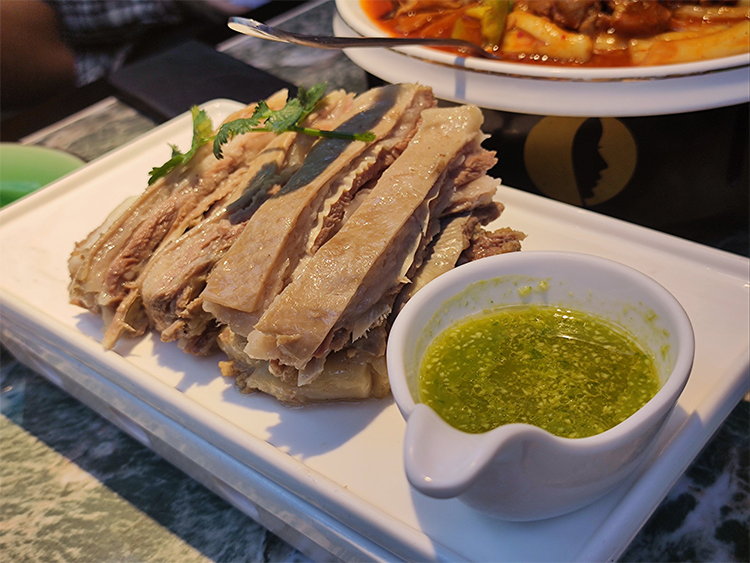Gansu Hand-Pulled Mutton: A Nomadic Lamb Feast
Gansu, a jewel in northwest China known for Silk Road heritage and red rock landforms, is equally celebrated for its rich culinary traditions. Among its iconic dishes stands hand-pulled mutton (often called hand-grabbed lamb)—a straightforward, deeply flavorful halal specialty beloved by local Muslim communities such as the Hui and Dongxiang. Imagine holding a steaming, aromatic chunk of tender lamb against a sweeping grassland backdrop, tearing it by hand and savoring pure, unadulterated meat flavor—this is the heart of Gansu cuisine. Ready to taste this fingertip feast? Let’s explore the story behind this legendary dish.
1. Origin History: Nomadic Wisdom Along the Silk Road
Hand-pulled mutton has evolved alongside Gansu’s pastoral cultures. Its roots trace to the region’s nomadic and Muslim minorities, including the Hui, Dongxiang, and Bonan peoples, whose livelihoods depended on shepherding. For convenience on the move, they developed a minimalist cooking method: simmer large cuts of freshly slaughtered lamb in water, seasoned only with salt, to preserve the meat’s original taste. As Silk Road trade flourished, travelers and merchants spread this method across northwest China, turning it into a ceremonial centerpiece for feasts and festivals.
2. Cultural Meaning: Hospitality and Celebration
In Gansu—especially places like Linxia Hui Autonomous Prefecture—hand-pulled mutton is more than food; it’s a cultural symbol. Locals say, “No sheep, no feast.” Whether for Eid al-Adha, Eid al-Fitr, weddings, or family gatherings, a generous platter of hand-pulled mutton signals the host’s warmth and generosity. Eating with your hands removes barriers created by utensils and reflects the region’s frank, hearty spirit. This shared, tactile ritual forges bonds and offers visitors a direct way to experience authentic northwest hospitality.

3. Ingredients: Gifts of the Loess Plateau and Grasslands
The dish’s excellence begins with premium lamb. Gansu’s highlands, abundant sunlight, and rich pastures produce well-fed flocks whose meat is tender and fragrant. Preferred choices include lambs younger than a year or well-raised adult local breeds such as Tang sheep or Dongxiang sheep. Grazing on natural grass and drinking mountain spring water, these animals offer meat with delicate texture, even fat distribution, and a subtle dairy aroma—free from strong gamey notes.
4. Cooking Process: Simple Techniques, Deep Respect
Hand-pulled mutton embodies the philosophy of “less is more.” Large bone-in pieces are placed into cold water and brought to a boil. Skimming foam carefully ensures a clear broth and pure meat aroma—a key step. Add just a few slices of fresh ginger, some white parts of scallion, and a measured amount of salt, then reduce to a gentle simmer. No heavy spices are used; cooking time varies by cut but typically lasts 1–2 hours until the meat is tender and nearly falling from the bone. The result: pale, succulent meat with a clear, flavorful broth that highlights the lamb itself.

5. Flavor and Texture: Pure, Tender, and Unadorned
When you taste hand-pulled mutton, the meat’s natural sweetness and subtle milkiness are immediate. The texture is exceptionally tender—often melting in the mouth—while retaining a satisfying bite in the lean fibers. Marbled fat softens and releases savory juices, blending with lean meat for rich, concentrated flavor. Without heavy seasoning, this concentrated lamb taste becomes the star, delivering a rustic yet moving culinary experience.
6. How to Eat: A Hands-On Tradition
As the name implies, eating by hand is central to the experience. Wash your hands, pick up a bone-in piece, dip it in a prepared sauce, then tear and eat. This unpretentious method breaks dining formalities and lets you connect directly with the food: tactile, liberating, and memorably joyful.

7. Tasting Tips: Classic Sauces and Perfect Pairings
Though the mutton is delicious on its own, dipping sauces elevate the meal. Three classic accompaniments are:
- Oil-poured chili (yóupō làzi): spicy, aromatic, and appetite-rousing.
- Crushed garlic with vinegar: brightens and cuts through richness.
- Dry cumin-chili mix: a northwest specialty that complements lamb beautifully.
Pair the dish with a bowl of the clear mutton broth, a pot of strong Northwest brick tea or gaiwan-brewed tea to cleanse the palate, and a crisp baked flatbread (kao mo) to complete the meal.
8. Traveler Tips: Where and When to Find Authentic Hand-Pulled Mutton
• Where to go: Head to Linxia, Lanzhou, and Gannan for authentic versions. Look for halal restaurants, local farmhouses, or long-established eateries favored by locals.
• Ordering: Restaurants often sell by weight—tell the server how many people and they’ll suggest portions. Popular cuts include ribs, neck, and leg.
• Best season: Autumn and winter are ideal, when the meat is fattier and more comforting.
• Etiquette: Respect Muslim dietary customs; alcohol is usually not served in halal venues.

9. Home Version: A Simple Northwest-Style Recipe
- Buy about one kilogram of fresh lamb ribs or leg.
- Place the meat in cold water with ginger slices and green onion segments. Bring to a boil and skim foam.
- Reduce to a simmer, add salt, and cook 1.5 hours until tender.
- Serve the meat with garlic paste, chili powder, and cumin for dipping.
While this home version can’t fully replicate Gansu’s local breeds and mountain pastures, it offers a vivid taste of northwest China’s bold, honest flavors.
Conclusion
Gansu hand-pulled mutton is more than a regional dish—it’s a cultural experience, a communal ritual, and a direct link to nomadic heritage. When you lift a warm piece of lamb with your hands and taste its pure aroma, you’re touching a living tradition. Plan your visit to Gansu and let your hands discover this heartfelt, generous gift from the grasslands.


